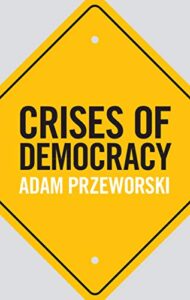American liberalism tends to swing between triumphalism and despair. Bill Clinton’s inauguration in 1992 was marked by Maya Angelou reading her poem “On the Pulse of Morning,” which promised that “The horizon leans forward/Offering you space to place new steps of change.” Just three years later, playwright Tony Kushner would give a speech declaring Newt Gingrich’s Republican Revolution “the scariest Congress this country has ever elected.” The despair of the George W. Bush years, when some liberals actually swallowed Karl Rove’s nonsense about a “permanent Republican majority,” gave way to elation at Barack Obama’s election, which in turn gave way to despair at the Tea Party surge in 2010. Donald Trump’s election in 2016 has, understandably, driven many to even deeper depths of despair, such that liberal intellectuals now openly contemplate whether democracy is about to exit the historical stage.
Adam Przeworski’s new book, Crises of Democracy, demonstrates that he is an unusual creature—a liberal with equanimity. Przeworski is a political scientist known for his work on the politics of redistribution, and his book is an intervention into recent discussions of populism and democratic decay. While many voices in that conversation pronounce confidently that the rise of right- and left-wing populisms over the last decade promises to doom democracy, Przeworski takes a decidedly more cautious approach to the matter. Moving fluently from quantitative comparisons of large numbers of countries across decades to detailed discussions of individual nations, Przeworski argues that while we know enough about democracy to throw cold water on outlandish predictions of its imminent demise, we do not know nearly enough to be complacent about its long-term prospects.
While many voices in that conversation pronounce confidently that the rise of right- and left-wing populisms over the last decade promises to doom democracy, Przeworski takes a decidedly more cautious approach to the matter.
After some initial conceptual ground-clearing concerning what, exactly, a crisis of democracy is, Przeworski moves into a discussion of the relationship between economics and democracy. At the heart of his argument is a simple but profound finding. In “economically developed countries,” he notes, “democracies are impregnable.” No country with a per capita GDP above about $2,000 has ever suffered a democratic collapse.
It is a striking empirical regularity, and one that those who constantly warn about a Trumpian Gleichschaltung would do well to consider. However, Przeworski is an honest enough researcher to admit that this kind of number-crunching is hardly sufficient to settle a question like the future of democracy. The future may well be different from the past.
The second half of the book thus takes up the question of what might be different this time around. Turning to the kinds of material that tends to preoccupy democratic doomsayers, like the collapse of the traditional parties in many democracies, and the rise of the far-right, Przeworski concludes that while these may be worrying trends, they are hardly dispositive of decline. Parties have fallen in the past without dragging the democratic system with them, and the parties of the far-right have generally failed to achieve anything like majoritarian support.
Przeworski argues that while we know enough about democracy to throw cold water on outlandish predictions of its imminent demise, we do not know nearly enough to be complacent about its long-term prospects.
Complacency, however, is hardly in order. While democratic collapse à la Weimar is highly unlikely in rich democracies, Przeworski suggests that “democratic backsliding” is a real possibility. This kind of process does not manifest itself in any single moment of rupture, like Augusto Pinochet’s overthrow of Salvador Allende. Instead, a party that comes to power through constitutional means can take a series of actions that, together, imperil the prospects of a democratic removal of that party from power. This is what has happened in the last decade in countries from Turkey to Venezuela. So far, these “democratic backsliders” have proven very difficult to remove from office.
This kind of democratic decline is much more realistic for a country like the United States than all-out democratic collapse. Przeworski even concludes his discussion of these dynamics with a hypothetical path by which it might happen in the United States, from a revival of the Alien and Sedition Acts to expanded gerrymandering to government by executive order.
Yet in the summer of 2020, it must be said that the odds for this kind of antidemocratic consolidation by the Trump administration appear lower than ever. The president’s party lost decisively in the midterm elections, and organized public opposition to Trump and GOP policies has been robust throughout his term. Though no one can deny Trump’s authoritarian instincts, he has failed miserably in governing by them.
While democratic collapse à la Weimar is highly unlikely in rich democracies, Przeworski suggests that “democratic backsliding” is a real possibility.
In all likelihood, we are headed for a renewed round of liberal triumphalism this November. Przeworski’s analysis suggests it will, like its predecessors, be short-lived. The combination of low economic growth and high inequality that has reigned in much of the developed world since the 1970s is a powerful force for disillusionment with democracy. People vote in the hopes that their lives will change for the better, and when successive elections are unable to deliver on that promise, the odds that they will look for alternatives to democracy for accomplishing that increase. “Since 1820,” Przeworski notes, “every generation in Europe and the United States lived and expected to live better than their parents, and yet this belief is being shattered.”
Trump’s tweets, in other words, are the least of what should be concerning democracy’s partisans in this moment. Without a change in the underlying economic order, anti-democratic politics are likely to continue to find a base. And their next standard-bearer might not be so incompetent.

